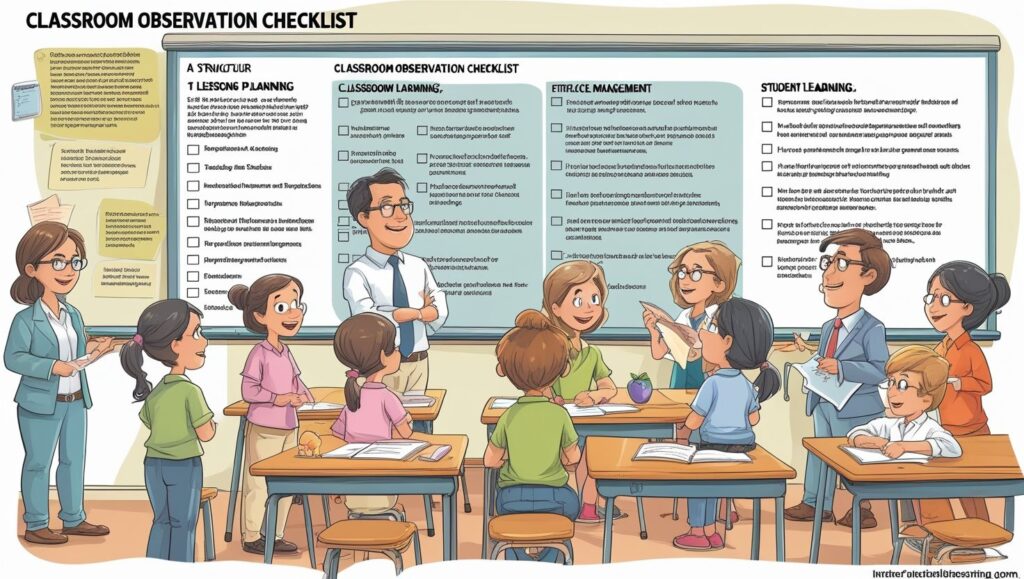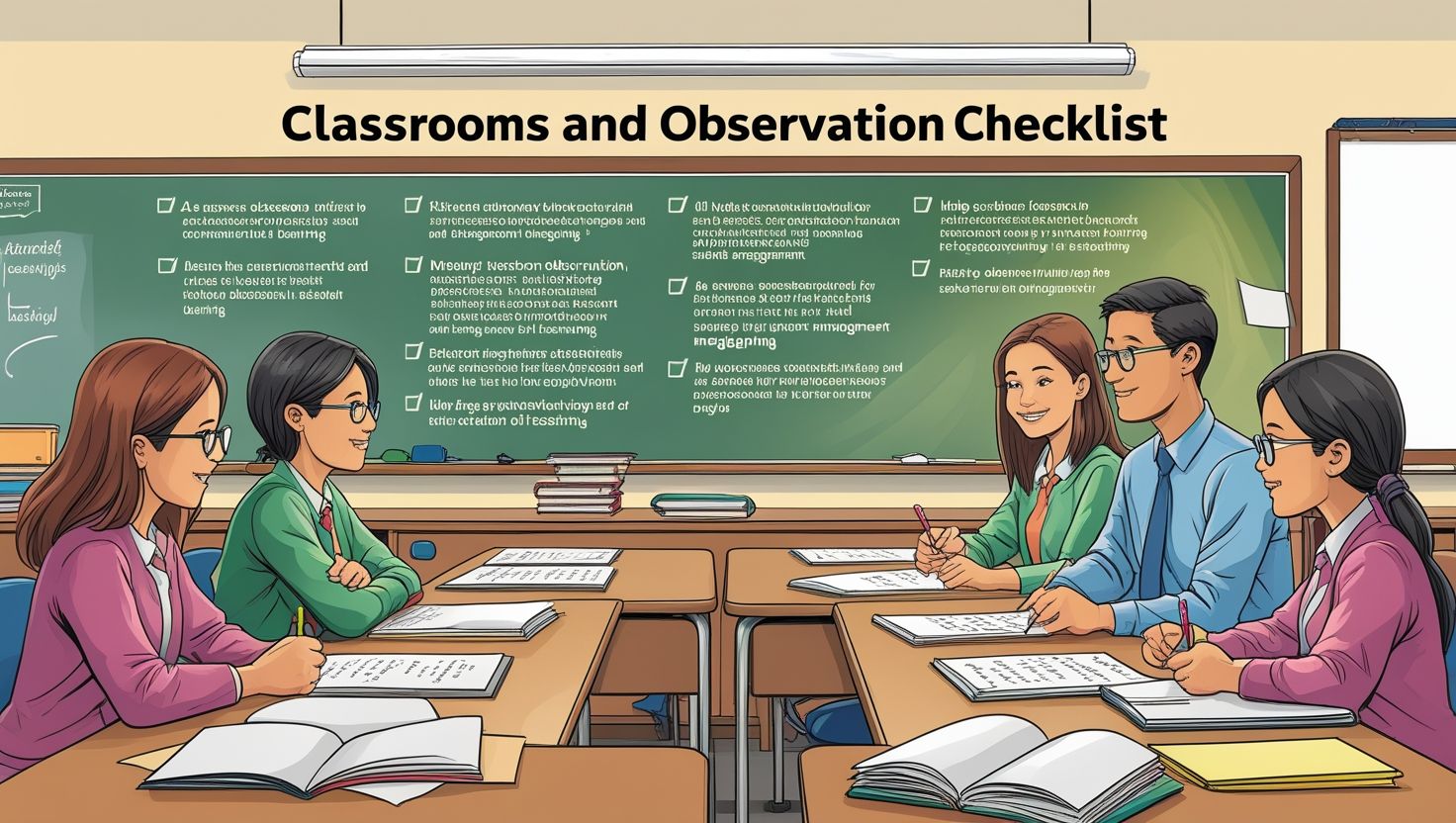Introduction
Classroom Observation Checklist, Classroom observation is a vital tool in education. It allows teachers, administrators, and supervisors to assess classroom practices effectively. Through structured observation, strengths and weaknesses in teaching methods are identified. Therefore, a classroom observation checklist becomes an important guide. It provides a systematic way to gather information about teacher performance and student learning. Moreover, it ensures objectivity and consistency. Without a checklist, observations may remain subjective and incomplete. Hence, the use of a checklist ensures clear focus on specific teaching elements. Additionally, it supports professional development by offering evidence-based feedback. Observers can note classroom management, teaching strategies, student engagement, and learning outcomes. In this way, observations contribute to quality assurance in education. Furthermore, the checklist also helps in improving teaching standards. It creates accountability and enhances reflective practices among teachers. Thus, a classroom observation checklist serves as a roadmap for improving learning and teaching processes across all grade levels.
Purpose of Classroom Observation Checklist
The main purpose of a classroom observation checklist is to guide evaluators during observations. It ensures that important aspects of teaching are not overlooked. Furthermore, it provides a structured tool for consistent assessment. Observers may focus on teacher behavior, instructional strategies, classroom climate, and student responses. With this structure, feedback becomes more precise and reliable. Additionally, the checklist supports teacher development. Teachers benefit from detailed insights that help them refine practices. It also promotes fairness since all teachers are evaluated against the same criteria. As a result, evaluations are transparent and standardized. Another purpose is to enhance accountability. Schools can ensure that teaching standards are met. Moreover, the checklist helps in identifying training needs. Teachers who struggle with certain areas receive targeted support. Thus, the purpose is not limited to evaluation but extends to growth. Consequently, classroom observation checklists become tools for professional improvement and institutional excellence.
Key Components of a Checklist
A classroom observation checklist contains several important components. Firstly, it often includes teacher preparation indicators. Observers check whether lessons are well planned and aligned with objectives. Secondly, it covers instructional methods. Teachers are assessed on clarity, questioning techniques, and use of resources. Thirdly, classroom management is evaluated. Discipline, organization, and time management play significant roles. Fourthly, student participation is considered. Observers look for interaction, engagement, and collaboration. Additionally, assessment practices form another part of the checklist. Teachers’ ability to measure understanding and provide feedback is crucial. Moreover, the checklist may include professional behavior. Respect, fairness, and effective communication are noted. In addition, technological integration is becoming increasingly important. Teachers are expected to incorporate digital tools appropriately. Lastly, inclusivity is also highlighted. Teachers must address diverse learning needs and promote equal opportunities. Hence, key components of the checklist reflect all aspects of teaching and learning.

Teacher Preparation and Planning
Teacher preparation and planning are vital aspects of effective teaching. A classroom observation checklist emphasizes this factor. Observers note whether teachers design lessons that meet curriculum requirements. Lesson objectives should be clear and achievable. Additionally, teachers must prepare suitable learning materials in advance. When planning is thorough, teaching becomes more organized and efficient. Furthermore, lesson pacing is important. Teachers must manage time to cover content without rushing or delaying. Planning also involves anticipating challenges. Teachers should prepare strategies to address potential difficulties. Moreover, linking lessons to previous knowledge helps students understand better. Observers also evaluate if teachers adapt plans to diverse learning needs. In this regard, flexibility is a sign of strong preparation. Hence, the checklist ensures that teaching is not random but carefully structured. Good planning results in smooth instruction and stronger learning outcomes. Therefore, preparation and planning remain a central focus of classroom observation.
Instructional Strategies
Instructional strategies form a critical element of classroom observation. Teachers must adopt varied methods to meet student needs. For instance, using lectures alone is insufficient. Observers expect interactive teaching strategies. These may include discussions, group work, role play, or project-based learning. Moreover, teachers should use visual aids and technology to support lessons. In addition, questioning techniques must encourage critical thinking. Simple recall questions are not enough. Effective questioning stimulates deeper understanding. Furthermore, teachers must differentiate instruction. Students learn at different paces, and strategies must reflect that. Observers also examine how teachers link theory with practice. Real-life examples make lessons more meaningful. Additionally, smooth transitions between activities demonstrate planning and skill. Effective strategies also require clear explanations and reinforcement. Teachers who provide feedback ensure continuous improvement. Therefore, instructional strategies serve as a foundation for quality teaching. Consequently, this section of the checklist strongly influences teacher evaluation.
Classroom Management
Classroom management is another key criterion within observation checklists. It refers to the ability of a teacher to maintain order and create a positive learning environment. Firstly, discipline is important. Teachers should establish rules and enforce them consistently. Secondly, time management is observed. Effective teachers use class time wisely without unnecessary delays. Additionally, seating arrangements influence participation. Well-organized classrooms enhance attention and collaboration. Furthermore, teachers must deal with disruptions calmly and fairly. Their ability to manage behavior reflects professional skill. Moreover, observers evaluate how teachers encourage responsibility among students. For instance, assigning roles during group work builds accountability. A respectful climate also matters. Teachers should treat all students fairly. Positive reinforcement motivates learners and reduces misbehavior. In addition, transitions between activities should be smooth. Disorderly changes often waste time and distract learners. Thus, classroom management strongly affects learning outcomes. It remains one of the most observed aspects during evaluation.

Student Engagement
Student engagement is central to effective teaching. Observers pay attention to how actively students participate in lessons. For instance, teachers should encourage interaction through questioning and discussion. Passive learning reduces understanding. Furthermore, varied activities capture student interest. Group work, experiments, and projects make learning more dynamic. Moreover, teachers should motivate students using positive reinforcement. Praising efforts encourages greater involvement. Additionally, inclusivity is important. Every student should have opportunities to contribute. Teachers must ensure that weaker students are not left behind. Observers also check body language and attentiveness. Students who remain alert reflect high engagement. Technology can further increase involvement. Digital tools, when used properly, make learning interactive. Furthermore, teachers should connect content with real-life situations. This increases relevance and curiosity. Engaged students ask questions, share ideas, and take responsibility for learning. Thus, student engagement becomes a key indicator of effective teaching and overall classroom success.
Assessment and Feedback
Assessment and feedback play a crucial role in the teaching process. A classroom observation checklist includes these elements for effective evaluation. Teachers must use various assessment methods to measure learning. For example, quizzes, oral questions, or assignments help in checking progress. Furthermore, assessment should align with lesson objectives. Observers also examine how feedback is provided. Constructive feedback supports student improvement. Moreover, timely responses are essential. Delayed feedback loses effectiveness. Additionally, teachers should encourage self-assessment. This practice fosters independence and reflection among learners. Observers also look for fairness in evaluation. Every student must be assessed without bias. Furthermore, teachers should identify gaps in understanding and adjust teaching accordingly. Feedback should not discourage but motivate learners. Clear explanations of errors guide students towards success. Thus, assessment and feedback form a cycle of improvement. In this way, they enhance learning outcomes and support continuous academic growth.
Professionalism and Teacher Behavior
Professionalism is an essential aspect of classroom observation. Teachers are expected to act as role models. Observers evaluate respect, fairness, and ethical conduct. Furthermore, teachers must demonstrate commitment to their responsibilities. Punctuality, preparation, and dedication reflect professionalism. Moreover, communication skills are crucial. Teachers should interact politely and clearly with students. Professional behavior also includes collaboration with colleagues. Supportive teamwork enhances the learning environment. Additionally, appearance and demeanor play roles. A professional outlook builds respect and authority. Observers also focus on teachers’ responsiveness to students’ needs. Empathy and patience show professional maturity. Furthermore, ethical behavior ensures fairness and equality. Teachers should avoid favoritism or discrimination. Moreover, willingness to accept feedback reflects professionalism. Teachers who learn and adapt continue to grow. Professionalism also extends beyond the classroom. Involvement in school activities shows responsibility. Hence, teacher behavior and professionalism are central in observation checklists. They significantly affect overall evaluation results.
Inclusivity and Differentiation
Inclusivity and differentiation are key factors in modern teaching. A classroom observation checklist pays close attention to them. Teachers must recognize and respect diversity in classrooms. Students differ in learning styles, abilities, and backgrounds. Therefore, teaching must be adapted accordingly. Observers note whether teachers provide equal opportunities for all learners. For instance, weaker students may need extra support. Similarly, gifted students should receive challenging tasks. Furthermore, inclusivity extends to cultural and social diversity. Teachers should use examples that represent varied perspectives. Moreover, differentiated instruction makes lessons accessible. Activities should suit different ability levels. Teachers must also use multiple teaching materials to meet needs. Additionally, inclusivity builds confidence among learners. When students feel valued, they engage more actively. Observers evaluate whether teachers create supportive environments. Classrooms should be free from bias or exclusion. Hence, inclusivity and differentiation enhance learning for all students. They are essential components of observation checklists.
Benefits of Using a Checklist
The use of a classroom observation checklist brings many benefits. Firstly, it ensures consistency in evaluation. All teachers are assessed against the same standards. Secondly, it promotes objectivity. Observers rely on clear criteria instead of personal opinions. Furthermore, checklists highlight strengths and weaknesses precisely. This allows teachers to focus on specific improvements. Additionally, checklists save time. Observers do not need to create evaluation tools from scratch. Moreover, they improve accountability within schools. Teachers understand that their performance is monitored fairly. Another benefit is professional development. Teachers use feedback to refine methods. Furthermore, students also benefit indirectly. Improved teaching results in better learning outcomes. Moreover, checklists enhance communication between supervisors and teachers. Clear records help in discussions and planning. In addition, they support institutional quality assurance. Schools can monitor teaching standards regularly. Thus, the benefits of using a checklist extend to teachers, students, and institutions equally.

Challenges in Using Checklists
Although beneficial, classroom observation checklists face some challenges. Firstly, they may encourage rigid evaluation. Teachers might feel restricted by fixed criteria. Secondly, overemphasis on checklists can ignore creativity. Teaching is dynamic and cannot always fit into boxes. Furthermore, some observers may misuse checklists. Bias or lack of training may affect results. Additionally, teachers sometimes experience stress during observation. Anxiety may reduce natural performance. Moreover, checklists may not fully capture complex teaching processes. Subtle elements like teacher-student rapport may be overlooked. Another challenge is the time factor. Detailed observation using checklists requires adequate time. Furthermore, feedback must be given constructively. Poor communication may discourage teachers instead of supporting them. Moreover, constant observation may create a feeling of surveillance. Teachers may resist or feel pressured. Therefore, challenges exist alongside benefits. Overcoming these challenges requires proper training, balanced use, and continuous refinement of observation checklists.
Conclusion
In conclusion, a classroom observation checklist is a powerful tool. It ensures structured, fair, and consistent evaluation of teaching. Moreover, it supports professional growth by highlighting strengths and weaknesses. Through systematic observation, teachers receive clear feedback. Additionally, checklists promote accountability within schools. They also enhance the overall quality of education. However, challenges such as rigidity, bias, and stress must be managed carefully. Balanced use is essential for effectiveness. Furthermore, proper training for observers enhances accuracy. Inclusivity, instructional strategies, classroom management, and assessment all remain central components. Thus, a well-designed checklist becomes more than just an evaluation tool. It turns into a guide for reflection and improvement. Ultimately, classroom observation checklists contribute to better teaching and stronger learning outcomes. Therefore, their importance in education cannot be overlooked. When applied thoughtfully, they empower teachers, engage students, and elevate institutional standards in meaningful and lasting ways.

hdp3st
I really like your blog.. very nice colors & theme.
Did you make this website yourself or did you hire someone to do it for you?
Plz replyy as I’m looking too construct my ownn bloog and would like to know where u got thios from.
cheers https://z42mi.Mssg.me/